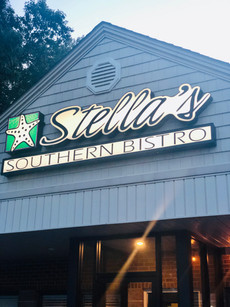Night Flying Around Storms & Dinner in Greenville, SC
- Melissa
- Sep 3, 2020
- 3 min read
Updated: Sep 10, 2020
Dinner-and-a-flight has become a new way for us to stay in regular contact with our adult children who live "relatively" close to us. Well, as far as nautical miles go. Three of our four adult children and their significant others live within a 90 minute flight (one way) from us. This makes it possible to fly in, have them pick us up, have dinner and fly home.
Last night we flew to Greenville, SC and enjoyed a fun evening with our son and his fiancée. We got our South Carolina on at Stellas Southern Bistro https://www.stellasbistro.com. We're talking catfish, grits, pickled okra and pimento cheese. An excellent meal and wonderful conversation.
And now, a word from the pilot about the flight home.
Some thoughts on night flying
Night flying introduces extra concerns that either don’t exist or are at least less of a concern during day flights: basic control of the airplane (“which way is up?”), navigation (“where are we, and where are we going?”), finding emergency landing sites (how many open fields have lights to make them easy to see?), and vision challenges (night vision is affected by even slight reductions in oxygen typical at flight altitudes), just to name a few. With a single engine airplane, it’s also natural to be more aware of even the slightest change in engine sound or feel at night, knowing that if the “fan up front” stops, the options are more limited than during daytime.
The route from Greenville, SC, to our home base. https://flightaware.com/live/flight/N539SR/history/20200903/0045Z/KGMU/KJVY
Most safety-conscious pilots consider night flying to be as challenging as IMC (instrument meteorological conditions; a.k.a. clouds) since it’s fairly common to have no visible horizon, or even worse, a false horizon caused by the hon-horizontal alignment of various lights visible below, if any are even visible. The “cure” is knowing how to fly by reference only to the instruments, and being able to ignore that seat-of-the-pants feeling of which way is up and trust the instruments.
The oft-stated safety mantra is “night, IMC, or mountains; pick one”. If you look at the route from Greenville, SC, to our home base just North of Louisville, KY, you can see we had to cross the Appalachian Mountains; some pretty rugged terrain. Not only that, but there was a line of light-to-moderate rain on the Northwest side of the mountains. For me, I reconcile that conflict of all three (night, IMC, and mountains) by knowing the airplane extremely well, including the avionics, and knowing that we have multiple data sources for nearly real-time weather information. We have both XM Radio aviation weather, and ADS-B weather in the plane, so I can cross-check these before and during flight to understand the movement of any showers and the rate at which they are getting stronger or weaker. In addition, we have a dual WAAS-enabled GPS navigation systems and a very capable autopilot to handle the mundane task of staying on course and altitude, so I can handle the route planning, radios, and the myriad other tasks involved. Had any of those many systems indicated any problem, we would have either stayed on the ground, or diverted to the nearest airport.
The airplane and systems onboard don’t know it’s dark outside; they only know the aerodynamics involved and to do what the pilot has told the systems to do. The smart pilot knows the options for dealing with the unexpected are more limited at night than during the day. Knowing and managing the associated risks is part of every flight, day or night.
One last point to make: our airplane is a Cirrus, and like every Cirrus airplane it has a whole airplane parachute. I hope we never have a need for it, but knowing that if the navigation systems and the autopilot, and even me (the pilot) all fail, my wife knows how to activate the ‘chute. That’s nice to have as a last resort risk mitigation tool.










Comments